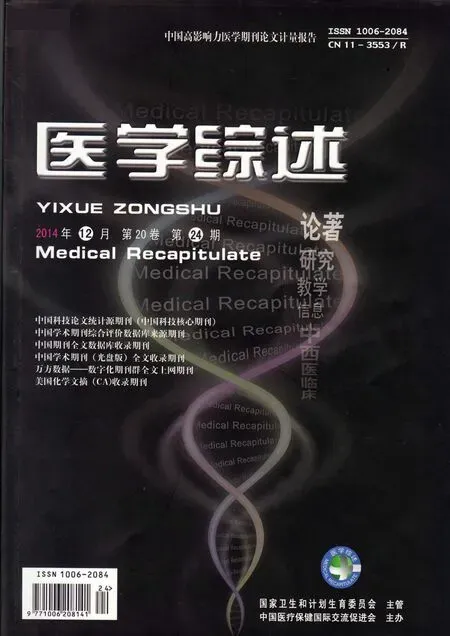Wnt信号通路和中枢神经系统疾病的研究进展
马义辉(综述),周 杰,荔志云(审校)
(兰州军区兰州总医院神经外科,兰州 730050)
Wnt基因是从小鼠乳腺癌中克隆出的一种原癌基因。Wnt基因编码的Wnt蛋白是分泌性蛋白,在脊椎动物中已发现至少20种,其中人类有16种,它们在细胞外基质中积累并激活相邻细胞中的信号通路。研究证实,Wnt信号通路的组成主要包括细胞外因子Wnt、跨膜受体卷曲蛋白、糖原合成激酶3β(glycogen synthase kinase 3β,GSK-3β)、β联蛋白(β-catenin)等[1]。Wnt在细胞内的通路通常被分成经典的Wnt/β-catenin通路和包括Wnt/Ca2+通路以及平面细胞极性通路的非经典通路。目前,大量的研究结果表明,Wnt信号通路参与调控胚胎正常发育、突触可塑性以及细胞增殖和分化等重要生理过程[2]。现就Wnt信号通路在脑卒中、阿尔茨海默病和帕金森病等中枢神经系统疾病中的研究进展进行综述。
1 Wnt信号通路的生物学功能
1.1Wnt信号通路和神经再生 大量的研究已经证实,Wnt信号通路是与哺乳动物胚胎时期神经系统发生关系最为密切的信号通路,其参与神经干细胞的增殖、分化、轴突形成等[3]。研究者利用基因剔除小鼠发现,Wnt1基因的缺失将导致小鼠中后脑发育的严重缺陷[4]。Lee等[5]研究结果提示,对于发育中的大脑皮质,Wnt3a在海马的形成过程中起着至关重要的作用。此外,还有研究提示,在皮质发育过程中,Wnt7a不仅能够促进神经细胞的分化,而且还能降低神经前体细胞自我更新的能力[6]。最近研究发现,在生理条件下,Wnt调控成年中枢神经系统内海马的神经发生[7]。Lie等[7]研究发现,过表达Wnt3能够增强海马区域的神经再生能力。Qu等[8]通过细胞周期分析发现,β-catenin能够促进神经干细胞的增殖和自我更新。此外,Woodhead等[9]研究证实,抑制β-catenin信号能够促进神经干细胞向神经元分化。Muroyama等[10]采用外源性Wnt3a与神经干细胞共培养的方法,证实诱导分化后的神经元和星形胶质细胞比例增高,而少突胶质细胞比例减少。总之,现有的研究证实,Wnt信号通路不仅在胚胎期参与神经干细胞的增殖、分化等过程发挥作用,而且在成年脑内的神经干细胞的增殖和分化方面也发挥着重要作用。
1.2Wnt信号通路和突触 近年来,大量的研究证实,Wnt信号通路在突触发生、突触囊泡循环、神经递质受体的转运以及受体和突触后膜上的锚蛋白相互作用等生理过程中发挥着重要作用[11]。Hall等[12]证实,Wnt7a通过诱导小脑颗粒细胞上synapsinⅠ的募集从而促进突触发生。此外,还有研究证实,Wnt7a参与成熟海马神经元的突触囊泡循环和突触传递过程[13]。Farias等[14]的研究发现,Wnt通过激活非经典通路Wnt-Ca2+和Wnt-c-Jun氨基末端激酶(c-Jun N-terminal kinase,JNK)通路增加海马神经元树突棘上突触后致密蛋白95的募集数量。最近的一些研究发现,Wnt的部分配体在小鼠海马神经元的突触可塑性方面发挥着一定作用[15-16]。Chen等[15]研究发现,在谷氨酸突触上,Wnt3a以一种活动依赖性的方式释放,阻断Wnt信号通路能够减弱长时程增强效应。过表达GSK-3β则能够阻断长时程增强效应的发生,并造成小鼠空间学习能力的下降[16]。
1.3Wnt信号通路和血管再生 最近的一些研究证实,Wnt信号通路尤其是Wnt/β-catenin通路在神经系统中血管再生、血管重构和血脑屏障的形成等方面均发挥重要作用。Maretto等[17]发现,在胚胎期的特定时间,血管上血管内皮细胞进入中枢神经系统时伴随着Wnt/β-catenin通路的激活。而且最新的研究发现,Wnt7a/7b通过激活Wnt/β-catenin通路参与中枢神经系统的血管再生[18]。Liebner等[19]发现,Wnt/β-catenin通路还参与胚胎期血脑屏障的形成和出生后血脑屏障完整性的保持。
2 Wnt信号通路与中枢神经系统疾病
2.1阿尔茨海默病 人类的神经退行性疾病(如阿尔茨海默病)的研究表明,Wnt/β-catenin通路参与了该疾病的病理生理学过程。阿尔茨海默病的特征性改变是β淀粉样蛋白积累导致新生成的神经元发生细胞凋亡。He等[20]通过分离培养阿尔茨海默病患者颞叶皮质的胶质样前体细胞发现,神经前体细胞自我更新能力的下降可能与GSK-3β的活性的增加以及β-catenin的磷酸化相关,将β-catenin转染至上述神经前体细胞,则能够部分恢复其神经再生能力。有研究表明,β淀粉样蛋白依赖的神经毒性与Wnt信号通路的部分组成蛋白的失活有关[21]。Farias等[22]的研究发现,神经元暴露于β淀粉样蛋白中,将导致细胞凋亡和Tau蛋白的过度磷酸化,而该过程依赖于GSK-3β的活性。最新的研究表明,外源性上调β-catenin能够抑制β淀粉样蛋白诱导的细胞凋亡,而剔除β-catenin基因则能够拮抗Tau蛋白的抗凋亡作用[23]。β-catenin和GSK-3β均是Wnt信号通路的下游关键分子,也提示Wnt信号通路可能在阿尔茨海默病的病理生理机制中发挥着重要作用。
2.2脑卒中 许多研究证实,局灶性脑缺血刺激室管膜下区的神经前体细胞增殖并向缺血区迁移,但是仅有极少数的能够分化为成熟神经元[24-25]。李慧等[26]发现,缺血性脑损伤可刺激Wnt7在成年海马海马齿状回颗粒下区的表达上调,提示Wnt7可能通过经典Wnt通路参与调节脑缺血后成年海马海马齿状回颗粒下区的神经发生。Mastroiacovo等[27]将内皮素1注入大鼠脑实质造成大鼠的短暂性脑缺血后发现,Dickkopf-1的表达在纹状体、缺血中心和半暗带区均显著增加,而β-catenin的表达有所减少,而且该过程和缺血造成的脑损伤有关,外源性给予Lithium能够增强β-catenin的表达并对缺血后脑组织具有一定的保护作用。Cappuccio等[28]在沙鼠的全脑缺血模型中进一步证实,Dickkopf-1和缺血性脑损伤导致的神经元死亡相关。Shruster等[29]将过表达Wnt3a的慢病毒载体导入脑缺血大鼠的纹状体和室管膜下区后发现,Wnt3a增强了局灶性脑缺血后的神经再生并对神经功能障碍有一定的改善。
2.3帕金森病 帕金森病作为人类常见的神经退行性疾病,其特征性的病理学改变是中脑多巴胺能神经元的丧失。L′Episcopo等[30]利用1-methyl-4-phenyl-1,2,3,6-tetrahydropyridine(MPTP)诱导的帕金森病动物模型发现,黑质纹状体的损伤和Wnt/β-catenin通路的激活相关。他们首先通过离体实验证实,激活的星形胶质细胞和Wnt1/β-catenin通路可以改善MPTP诱导的多巴胺能神经元的细胞毒性作用;动物实验进一步证实,外源性给予Wnt1能够改善MPTP诱导的黑质纹状体损伤[30]。L′Episcopo等[31]还发现,老年小鼠的小胶质细胞功能异常和胶质细胞中Wnt1蛋白表达减少相关。Wang等[32]利用离体培养的神经元发现,抑制GSK-3β的活性能够减弱MPTP诱导的多巴胺能神经元的细胞毒性。此外,Petit-Paitel等[33]的研究证实,MPTP导致的神经元死亡和线粒体功能异常可能与细胞质中和线粒体中的GSK-3β的活性相关。
3 结 语
Wnt信号通路作为多细胞真核生物中的重要信号通路,参与调控胚胎正常发育、突触可塑性以及细胞增殖和分化等重要生理过程。尽管Wnt信号通路的研究多与肿瘤相关,但越来越多的研究证实,Wnt信号通路作为体内重要信号传递通路,在神经系统疾病(如阿尔茨海默病、脑卒中和帕金森病)的发生、发展中发挥着重要的作用。事实上,越来越多的证据还表明,Wnt信号通路在脑肿瘤和肌萎缩脊髓侧索硬化等其他中枢神经系统疾病的病理机制中也扮演着重要的角色。深入研究并阐明Wnt信号通路在中枢神经系统疾病中作用机制,可能会对相关疾病的治疗提供新靶点,开辟新的领域。
[1] Zhang L,Yang X,Yang S,etal.The Wnt /beta-catenin signaling pathway in the adult neurogenesis[J].Eur J Neurosci,2011,33(1):1-8.
[2] Toledo EM,Colombres M,Inestrosa NC.Wnt signaling in neuroprotection and stem cell differentiation[J].Prog Neurobiol,2008,86(3):281-296.
[3] Clevers H.Wnt/beta-catenin signaling in development and disease[J].Cell,2006,127(3):469-480.
[4] McMahon AP,Bradley A.The Wnt-1 (int-1) proto-oncogene is required for development of a large region of the mouse brain[J].Cell,1990,62(6):1073-1085.
[5] Lee SM,Tole S,Grove E,etal.A local Wnt-3a signal is required for development of the mammalian hippocampus[J].Development,2000,127(3):457-467.
[6] Viti J,Gulacsi A,Lillien L.Wnt regulation of progenitor maturation in the cortex depends on Shh or fibroblast growth factor 2[J].J Neurosci,2003,23(13):5919-5927.
[7] Lie DC,Colamarino SA,Song HJ,etal.Wntsignalling regulates adult hippocampal neurogenesis[J].Nature,2005,437(7063):1370-1375.
[8] Qu Q,Sun G,Li W,etal.Orphan nuclear receptor TLX activates Wnt/beta-catenin signalling to stimulate neural stem cell proliferation and self-renewal[J].Nat Cell Biol,2010,12(1):31-40.
[9] Woodhead GJ,Mutch CA,Olson EC,etal.Cell-autonomous beta-catenin signaling regulates cortical precursor proliferation[J].J Neurosci,2006,26(48):12620-12630.
[10] Muroyama Y,Kondoh H,Takada S.Wnt proteins promote neuronal differentiation in neural stem cell culture[J].Biochem Biophys Res Commun,2004,313(4):915-921.
[11] Inestrosa NC,Arenas E.Emerging roles of Wnts in the adult nervous system[J].Nat Rev Neurosci,2010,11(2):77-86.
[12] Hall AC,Lucas FR,Salinas PC.Axonal remodeling and synaptic differentiation in the cerebellum is regulated by WNT-7a signaling[J].Cell,2000,100(5):525-535.
[13] Cerpa W,Godoy JA,Alfaro I,etal.Wnt-7a modulates the synaptic vesicle cycle and synaptic transmission in hippocampal neurons[J].J Biol Chem,2008,283(9):5918-5927.
[14] Farias GG,Alfaro IE,Cerpa W,etal.Wnt-5a/JNK signaling promotes the clustering of PSD-95 in hippocampal neurons[J].J Biol Chem,2009,284(23):15857-15866.
[15] Chen J,Park CS,Tang SJ.Activity-dependent synaptic Wnt release regulates hippocampal long term potentiation[J].J Biol Chem,2006,281(17):11910-11916.
[16] Hooper C,Markevich V,Plattner F,etal.Glycogen synthase kinase-3 inhibition is integral to long-term potentiation[J].Eur J Neurosci,2007,25(1):81-86.
[17] Maretto S,Cordenonsi M,Dupont S,etal.Mapping Wnt/beta-catenin signaling during mouse development and in colorectal tumors[J].Proc Natl Acad Sci U S A,2003,100(6):3299-3304.
[18] Stenman JM,Rajagopal J,Carroll TJ,etal.Canonical Wnt signaling regulates organ-specific assembly and differentiation of CNS vasculature[J].Science,2008,322(5905):1247-1250.
[19] Liebner S,Corada M,Bangsow T,etal.Wnt/beta-catenin signaling controls development of the blood-brain barrier[J].J Cell Biol,2008,183(3):409-417.
[20] He P,Shen Y.Interruption of beta-catenin signaling reduces neurogenesis in Alzheimer′s disease[J].J Neurosci,2009,29(20):6545-6557.
[21] Alvarez AR,Godoy JA,Mullendorff K,etal.Wnt-3a overcomes beta-amyloid toxicity in rat hippocampal neurons[J].Exp Cell Res,2004,297(1):186-196.
[22] Farias GG,Godoy JA,Hernandez F,etal.M1 muscarinic receptor activation protects neurons from beta-amyloid toxicity.A role for Wnt signaling pathway[J].Neurobiol Dis,2004,17(2):337-348.
[23] Li HL,Wang HH,Liu SJ,etal.Phosphorylation of tau antagonizes apoptosis by stabilizing beta-catenin,a mechanism involved in Alzheimer′s neurodegeneration[J].Proc Natl Acad Sci U S A,2007,104(9):3591-3596.
[24] Kernie SG,Parent JM.Forebrain neurogenesis after focal Ischemic and traumatic brain injury[J].Neurobiol Dis,2010,37(2):267-274.
[25] Kreuzberg M,Kanov E,Timofeev O,etal.Increased subventricular zone-derived cortical neurogenesis after ischemic lesion[J].Exp Neurol,2010,226(1):90-99.
[26] 李慧,黄景阳,陈海丽,等.脑缺血再灌注后大鼠海马Wnt7b的表达[J].山东大学学报:医学版,2013,51(2):7-11.
[27] Mastroiacovo F,Busceti CL,Biagioni F,etal.Induction of the Wnt antagonist,Dickkopf-1,contributes to the development of neuronal death in models of brain focal ischemia[J].J Cereb Blood Flow Metab,2009,29(2):264-276.
[28] Cappuccio I,Calderone A,Busceti CL,etal.Induction of Dickkopf-1,a negative modulator of the Wnt pathway,is required for the development of ischemic neuronal death[J].J Neurosci,2005,25(10):2647-2657.
[29] Shruster A,Ben-Zur T,Melamed E,etal.Wnt signaling enhances neurogenesis and improves neurological function after focal ischemic injury[J].PLoS One,2012,7(7):e40843.
[30] L′Episcopo F,Tirolo C,Testa N,etal.Reactive astrocytes and Wnt/beta-catenin signaling link nigrostriatal injury to repair in 1-methyl-4-phenyl-1,2,3,6-tetrahydropyridine model of Parkinson′s disease[J].Neurobiol Dis,2011,41(2):508-527.
[31] L′Episcopo F,Tirolo C,Testa N,etal.Plasticity of subventricular zone neuroprogenitors in MPTP (1-methyl-4-phenyl-1,2,3,6-tetrahydropyridine) mouse model of Parkinson′s disease involves cross talk between inflammatory and Wnt/beta-catenin signaling pathways.functional consequences for neuroprotection and repair[J].J Neurosci,2012,32(6):2062-2085.
[32] Wang W,Yang Y,Ying C,etal.Inhibition of glycogen synthase kinase-3beta protects dopaminergic neurons from MPTP toxicity[J].Neuropharmacology,2007,52(8):1678-1684.
[33] Petit-Paitel A,Brau F,Cazareth J,etal.Involvment of cytosolic and mitochondrial GSK-3beta in mitochondrial dysfunction and neuronal cell death of MPTP/MPP-treated neurons[J].PLoS One,2009,4(5):e5491.

